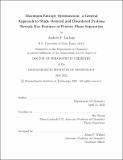Maximum Entropy Optimization: a General Approach to Study Ordered and Disordered Proteins Reveals Key Features of Protein Phase Separation
Author(s)
Latham, Andrew P.
DownloadThesis PDF (77.49Mb)
Advisor
Zhang, Bin
Terms of use
Metadata
Show full item recordAbstract
Liquid-liquid phase separation drives the formation of biological condensates that play essential roles in transcriptional regulation and signal sensing. The molecular factors that dictate these condensates' stability and spatial organization are not fully understood, and it remains challenging to predict their microstructures. Computational modeling could provide high-resolution structural characterizations of these condensates and help uncover physicochemical interactions that dictate their stability. However, the presence of both ordered and disordered domains in these proteins places a high demand on the model accuracy. In this thesis, we develop systematic methods to parameterize force fields from experimental data, and apply them to study the phase separation properties of chromatin regulator proteins.
In chapter 2, we develop a highly efficient maximum entropy approach to fit SAXS data by introducing minimal biases to a coarse-grained protein force field, the associative memory, water mediated, structure and energy model (AWSEM). In chapter 3, we present a generic algorithm to improve the accuracy of coarse-grained IDP models using a diverse set of experimental measurements. It combines maximum entropy optimization and least squares regression to systematically adjust model parameters and improve the agreement between simulation and experiment. In chapter 4, we present an algorithm to derive a coarse-grained force field, MOFF, that can model both ordered and disordered proteins with consistent accuracy. We further applied MOFF to study the phase behavior of HP1, an essential protein for posttranslational modification and spatial organization of chromatin. The force field successfully resolved the structural difference of two HP1 homologs, despite their high sequence similarity. We carried out large scale simulations with hundreds of proteins to determine the critical temperature of phase separation and uncover multivalent interactions that stabilize higher-order assemblies. In chapter 5, we combine MOFF with a chemically accurate DNA model to study the phase behavior of chromatin regulators that are crucial for heterochromatin organization and their interactions with DNA. Notably, a layered organization was observed in condensates formed by mixing HP1, histone H1, and DNA. This layered organization may be of biological relevance as it enables cooperative DNA packaging between the two chromatin regulators.
Date issued
2022-05Department
Massachusetts Institute of Technology. Department of ChemistryPublisher
Massachusetts Institute of Technology